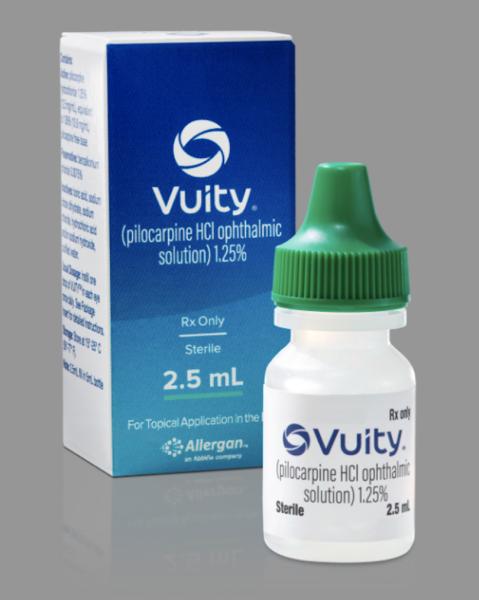Generic Vuity Availability
Last updated on Aug 6, 2025.
Vuity is a brand name of pilocarpine ophthalmic, approved by the FDA in the following formulation(s):
VUITY (pilocarpine hydrochloride - solution;ophthalmic)
Is there a generic version of Vuity available?
A generic version of Vuity has been approved by the FDA. However, this does not mean that the product will necessarily be commercially available - possibly because of drug patents and/or drug exclusivity. The following products are equivalent to Vuity and have been approved by the FDA:
pilocarpine hydrochloride solution;ophthalmic
-
Manufacturer: AMNEAL
Approval date: April 28, 2025
Strength(s): 1.25% [AB]
Note: Fraudulent online pharmacies may attempt to sell an illegal generic version of Vuity. These medications may be counterfeit and potentially unsafe. If you purchase medications online, be sure you are buying from a reputable and valid online pharmacy. Ask your health care provider for advice if you are unsure about the online purchase of any medication.
See also: Generic Drug FAQ.
Related patents
Patents are granted by the U.S. Patent and Trademark Office at any time during a drug's development and may include a wide range of claims.
-
Presbyopia treatments
Patent 10,610,518
Issued: April 7, 2020
Inventor(s): Robinson Michael R. & Dibas Mohammed & Giyanani Jaya & Gore Anuradha & Lee Sungwook & Liu Haixia & Morgan Aileen & Zhou Jihao
Assignee(s): ALLERGAN, INC.Described herein are methods and compositions for the treatment of ocular conditions and for the improvement of vision parameters using pharmaceutically acceptable ophthalmic pilocarpine formulations. A nonlimiting example of an ocular condition that may be treated with the methods and compositions disclosed herein is presbyopia.
Patent expiration dates:
- April 24, 2039✓
- April 24, 2039✓
- April 24, 2039✓
- April 24, 2039
-
Presbyopia treatments
Patent 11,285,134
Issued: March 29, 2022
Inventor(s): Robinson Michael R. & Dibas Mohammed & Giyanani Jaya & Gore Anuradha & Lee Sungwook & Liu Haixia & Morgan Aileen & Zhou Jihao
Assignee(s): ALLERGAN, INC.Described herein are methods and compositions for the treatment of ocular conditions and for the improvement of vision parameters using pharmaceutically acceptable ophthalmic pilocarpine formulations. A nonlimiting example of an ocular condition that may be treated with the methods and compositions disclosed herein is presbyopia.
Patent expiration dates:
- April 24, 2039✓
- April 24, 2039✓
- April 24, 2039✓
- April 24, 2039
Related exclusivities
Exclusivity is exclusive marketing rights granted by the FDA upon approval of a drug and can run concurrently with a patent or not. Exclusivity is a statutory provision and is granted to an NDA applicant if statutory requirements are met.
Exclusivity expiration dates:
- March 28, 2026 - ADDITION OF SECOND DOSE FOR TREATMENT OF PRESBYOPIA IN ADULTS
More about Vuity (pilocarpine ophthalmic)
- Check interactions
- Compare alternatives
- Pricing & coupons
- Reviews (1)
- Drug images
- Side effects
- Dosage information
- During pregnancy
- FDA approval history
- Breastfeeding
- En español
Patient resources
Other brands
Qlosi, Pilocar, Isopto Carpine, Ocu-Carpine, Pilopine HS
Professional resources
- Vuity Eye Drops prescribing information
- Pilocarpine, Pilocarpine Hydrochloride, Pilocarpine Nitrate (Ophthalmic) (AHFS Monograph)
Other brands
Related treatment guides
Related/similar drugs
Glossary
| Term | Definition |
|---|---|
| Drug Patent | A drug patent is assigned by the U.S. Patent and Trademark Office and assigns exclusive legal right to the patent holder to protect the proprietary chemical formulation. The patent assigns exclusive legal right to the inventor or patent holder, and may include entities such as the drug brand name, trademark, product dosage form, ingredient formulation, or manufacturing process A patent usually expires 20 years from the date of filing, but can be variable based on many factors, including development of new formulations of the original chemical, and patent infringement litigation. |
| Drug Exclusivity | Exclusivity is the sole marketing rights granted by the FDA to a manufacturer upon the approval of a drug and may run simultaneously with a patent. Exclusivity periods can run from 180 days to seven years depending upon the circumstance of the exclusivity grant. |
| RLD | A Reference Listed Drug (RLD) is an approved drug product to which new generic versions are compared to show that they are bioequivalent. A drug company seeking approval to market a generic equivalent must refer to the Reference Listed Drug in its Abbreviated New Drug Application (ANDA). By designating a single reference listed drug as the standard to which all generic versions must be shown to be bioequivalent, FDA hopes to avoid possible significant variations among generic drugs and their brand name counterpart. |
| AB | Products meeting necessary bioequivalence requirements. Multisource drug products listed under the same heading (e.g. identical active ingredients, dosage form, and routes of administration) and having the same strength (see Therapeutic Equivalence-Related Terms, Pharmaceutical Equivalents) generally will be coded AB if a study is submitted demonstrating bioequivalence. In certain instances, a number is added to the end of the AB code to make a three character code (e.g. AB1, AB2, AB7). Three-character codes are assigned only in situations when more than one reference listed drug of the same strength has been designated under the same heading. Two or more reference listed drugs are generally selected only when there are at least two potential reference drug products which are not bioequivalent to each other. If a study is submitted that demonstrates bioequivalence to a specific listed drug product, the generic product will be given the same three-character code as the reference listed drug it was compared against. |
Further information
Always consult your healthcare provider to ensure the information displayed on this page applies to your personal circumstances.

